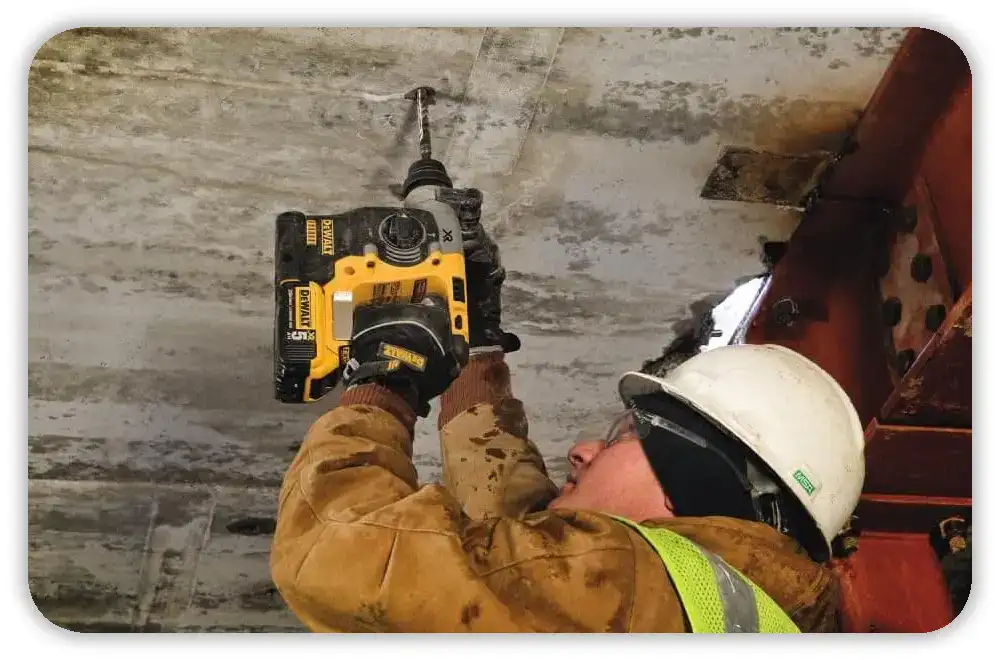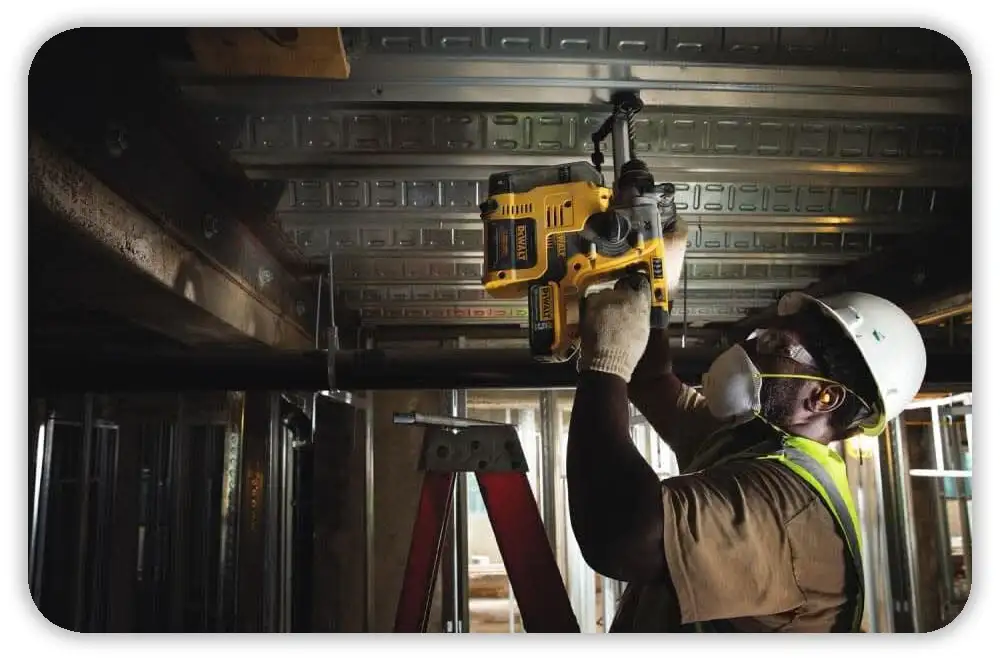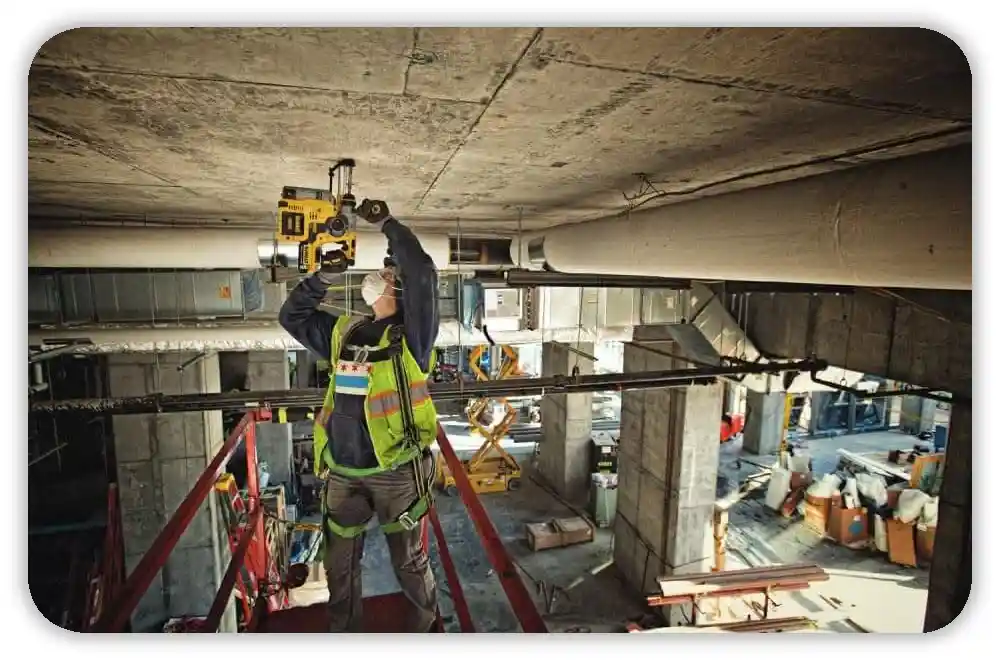Last Saturday, I was in my warm Ohio garage. Coffee beside me, tunes on, and dust in the air. I was drilling anchors into a wall when my DeWalt hammer drill went click—then nothing. Just silence.
If your DeWalt hammer drill stopped working, don’t panic. I’ve been there more than once. Let’s walk through what I learned and how to get it running again fast.
Table of Contents
Common Reasons Your DeWalt Hammer Drill Quits Mid-Job
When your drill dies mid-hole, there’s always a reason. Most are simple, and you can check them in minutes.

1. Battery or Charger Trouble
If it’s cordless, start here.
- Swap in another 20V MAX pack if you have one.
- A blinking red light on the charger means a bad or overheated battery.
- Clean the gold contacts with a pencil eraser. (Yes, it works better than wipes.)
2. Worn Carbon Brushes
This one caught me off guard one summer while building a deck.
- Take out the small yellow brush caps.
- The brushes should be longer than ¼ inch.
- If they’re tiny or chipped, replace them.
- In a pinch, I once used Milwaukee brushes—they fit close enough to finish the job.
3. Overheating or Thermal Cutoff
Drilling non-stop in hot weather makes the drill shut off to protect itself.
If the body feels hot or smells like burnt plastic, set it down for 10–15 minutes.
That built-in thermal fuse will reset once it cools off.
4. Jammed Chuck or Dust Buildup
Cement dust is sneaky. It slips into every gap.
- Blast air into the chuck to clear it.
- Add a drop of WD-40 and twist it a few times.
- Never use a spade bit in hammer mode—learned that the hard way back in 1998.
5. Bad Switch or Cord (for Corded Models)
On my old DW511, a cracked cord was the issue.
- Test the cord and switch with a multimeter.
- If there’s no signal, replace the part.
- Use UL-listed cords only—cheap ones can shock or short out.
Quick DIY Checks You Can Do in 5 Minutes
You don’t need a full workshop. Just a screwdriver and a multimeter.
- Swap batteries first to rule out a dead one.
- Check voltage: a full DeWalt 20V MAX should read around 20 volts.
- Test continuity on the cord if it’s a plug-in drill.
- Smell and listen: clicking or burning smells tell a lot.
These checks take minutes and often fix the issue right there.
When It’s Actually Broken (And OSHA Says Stop Using It)
If your drill sparks, smokes, or smells burnt, stop now.

- Sparks from vents mean worn brushes or a bad motor.
- A melting plastic smell? Internal short.
- A wobbly chuck means broken gears inside.
I once dropped my DeWalt DCH273 from a 12-foot ladder. It made a loud grind and lost all hammer action. No fixing that one—it went to recycling.
Repair vs. Replace: The Smart Call
Sometimes it’s cheaper to repair. Other times, you’re better off getting a new drill.
| Situation | Repair Cost | New Drill | What I’d Do |
| Under warranty (3 years) | $0 | $199 | Fix it |
| Brush swap | $15 + 20 min | $199 | Fix if under 2 years old |
| Internal damage | $80–$120 | $199 | Replace |
My advice:
- Check DeWalt’s warranty portal (super easy to use).
- Get OEM brushes from ereplacementparts.com.
- Watch iFixit videos before you open anything.
Habits That Keep Your Drill Alive Longer
After burning through three drills, I’ve changed how I work.

- Blow dust out after each concrete job.
- Let it cool for two minutes every few holes.
- Use SDS-Plus bits in hammer mode only.
- Keep it indoors—truck beds kill motors in the cold.
- Check your brushes every few months.
Since I started doing this, my DeWalt DCD996 has lasted twice as long.
When to Let It Go
Some drills just deserve retirement. My DW511 had tape around the cord and smelled like ozone. I finally replaced it with a DeWalt XR brushless. The new one runs smoother, quieter, and the anti-vibe feature saved my wrists during a Michigan basement remodel.
If the repair cost hits 60% of a new drill, and it’s out of warranty—replace it. You’ll save time, frustration, and maybe a few curse words.
Final Thoughts
When your DeWalt hammer drill stops working, it’s easy to panic. But most fixes are simple. A clean, cool, and well-kept drill lasts for years.
And if it’s truly done? Let it go with pride—it’s probably earned its rest.
(Tested on my DCD996, DCH273, and the faithful old DW511 that finally retired to the scrap bin.)
FAQs for DeWalt Hammer Drill Stopped Working
Why has my DeWalt hammer drill stopped working suddenly?
Your DeWalt hammer drill may have a dead battery, worn brushes, or dust in the motor. Try a new battery and clean the vents before deeper repair.
How do I fix my DeWalt hammer drill that won’t spin?
Check the chuck for dust or jams. Blow air through it, add a drop of oil, and try again. If it still won’t spin, test the trigger switch and motor.
What does a flashing red light on my DeWalt charger mean?
A flashing red light shows a bad or overheated battery. Let it cool, clean the contacts, and retry charging with a working DeWalt 20V MAX pack.
Can I replace carbon brushes in my DeWalt hammer drill myself?
Yes, you can. Remove the yellow brush caps, pull out the old brushes, and slide in new ones. Make sure they’re OEM or match your drill model.
When should I replace my DeWalt hammer drill instead of fixing it?
If repair costs reach 60% of a new drill or it’s out of warranty, replace it. New brushless DeWalt models run cooler and last much longer.

